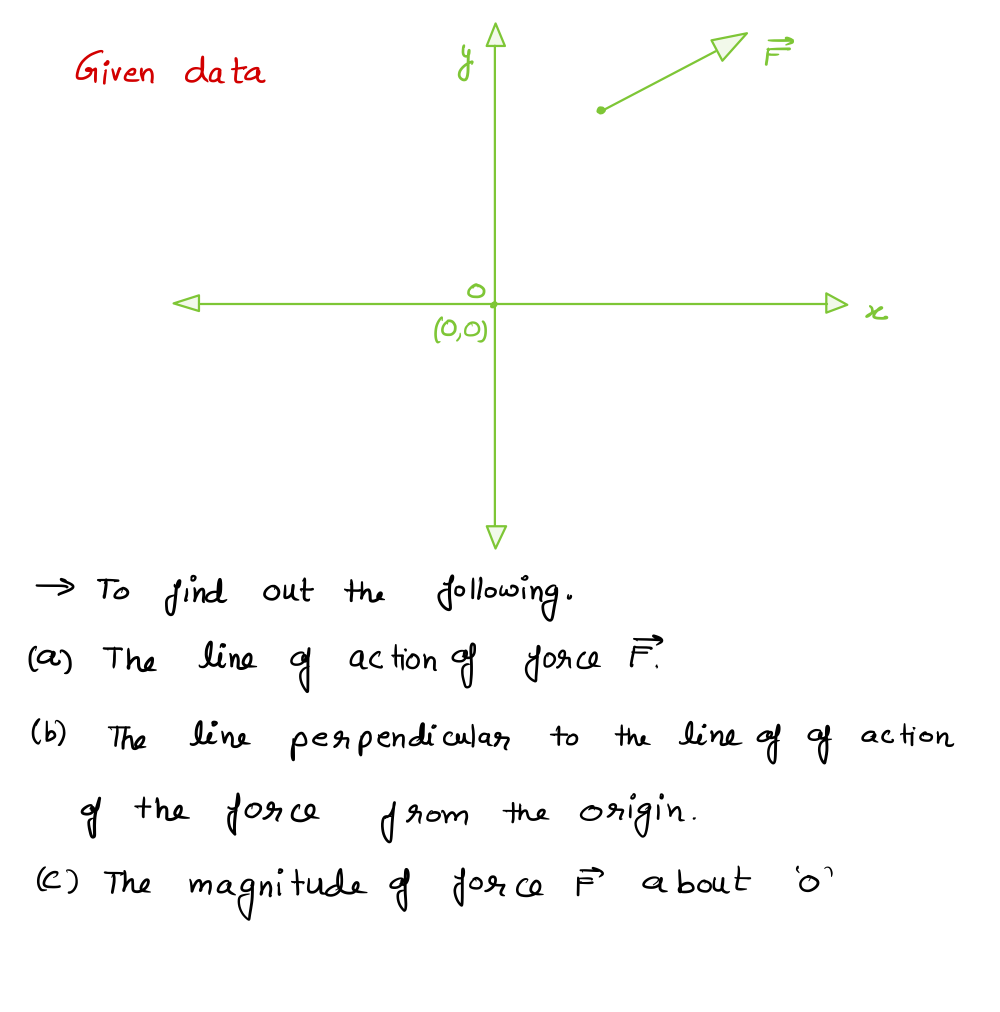For the 2d coordinate system below, complete the following: a) Draw a dashed line that is parallel to (and passes through) the force vector F. This is known as the "line of action" of F b) Draw a line that represents the distance (d) from the origin to the dashed line from the previous step. This distance must be shown as perpendicular to the dashed line. c) The "moment" of force F about the origin is equal to the magnitude of F times the distance d. Assume that a counterclockwise rotation about the origin is a "positive" moment. Think of d as a string connected to the origin. If you pull the string in the direction of F, will that cause a clockwise (-) or counterclockwise (+) moment? y
For the 2d coordinate system below, complete the following: a) Draw a dashed line that is parallel to (and passes through) the force vector F. This is known as the "line of action" of F b) Draw a line that represents the distance (d) from the origin to the dashed line from the previous step. This distance must be shown as perpendicular to the dashed line. c) The "moment" of force F about the origin is equal to the magnitude of F times the distance d. Assume that a counterclockwise rotation about the origin is a "positive" moment. Think of d as a string connected to the origin. If you pull the string in the direction of F, will that cause a clockwise (-) or counterclockwise (+) moment? y
Elements Of Electromagnetics
7th Edition
ISBN:9780190698614
Author:Sadiku, Matthew N. O.
Publisher:Sadiku, Matthew N. O.
ChapterMA: Math Assessment
Section: Chapter Questions
Problem 1.1MA
Related questions
Question

Transcribed Image Text:Warm-up
For the 2d coordinate system below, complete the following:
a) Draw a dashed line that is parallel to (and passes through) the force vector F.
This is known as the "line of action" of F
b) Draw a line that represents the distance (d) from the origin to the dashed line from the previous step.
This distance must be shown as perpendicular to the dashed line.
c) The "moment" of force F about the origin is equal to the magnitude of F times the distance d.
Assume that a counterclockwise rotation about the origin is a "positive" moment. Think of d as
a string connected to the origin. If you pull the string in the direction of F, will that cause a
clockwise (-) or counterclockwise (+) moment?
יך
O
X
Expert Solution
Step 1

Step by step
Solved in 3 steps with 3 images

Knowledge Booster
Learn more about
Need a deep-dive on the concept behind this application? Look no further. Learn more about this topic, mechanical-engineering and related others by exploring similar questions and additional content below.Recommended textbooks for you

Elements Of Electromagnetics
Mechanical Engineering
ISBN:
9780190698614
Author:
Sadiku, Matthew N. O.
Publisher:
Oxford University Press

Mechanics of Materials (10th Edition)
Mechanical Engineering
ISBN:
9780134319650
Author:
Russell C. Hibbeler
Publisher:
PEARSON

Thermodynamics: An Engineering Approach
Mechanical Engineering
ISBN:
9781259822674
Author:
Yunus A. Cengel Dr., Michael A. Boles
Publisher:
McGraw-Hill Education

Elements Of Electromagnetics
Mechanical Engineering
ISBN:
9780190698614
Author:
Sadiku, Matthew N. O.
Publisher:
Oxford University Press

Mechanics of Materials (10th Edition)
Mechanical Engineering
ISBN:
9780134319650
Author:
Russell C. Hibbeler
Publisher:
PEARSON

Thermodynamics: An Engineering Approach
Mechanical Engineering
ISBN:
9781259822674
Author:
Yunus A. Cengel Dr., Michael A. Boles
Publisher:
McGraw-Hill Education

Control Systems Engineering
Mechanical Engineering
ISBN:
9781118170519
Author:
Norman S. Nise
Publisher:
WILEY

Mechanics of Materials (MindTap Course List)
Mechanical Engineering
ISBN:
9781337093347
Author:
Barry J. Goodno, James M. Gere
Publisher:
Cengage Learning

Engineering Mechanics: Statics
Mechanical Engineering
ISBN:
9781118807330
Author:
James L. Meriam, L. G. Kraige, J. N. Bolton
Publisher:
WILEY